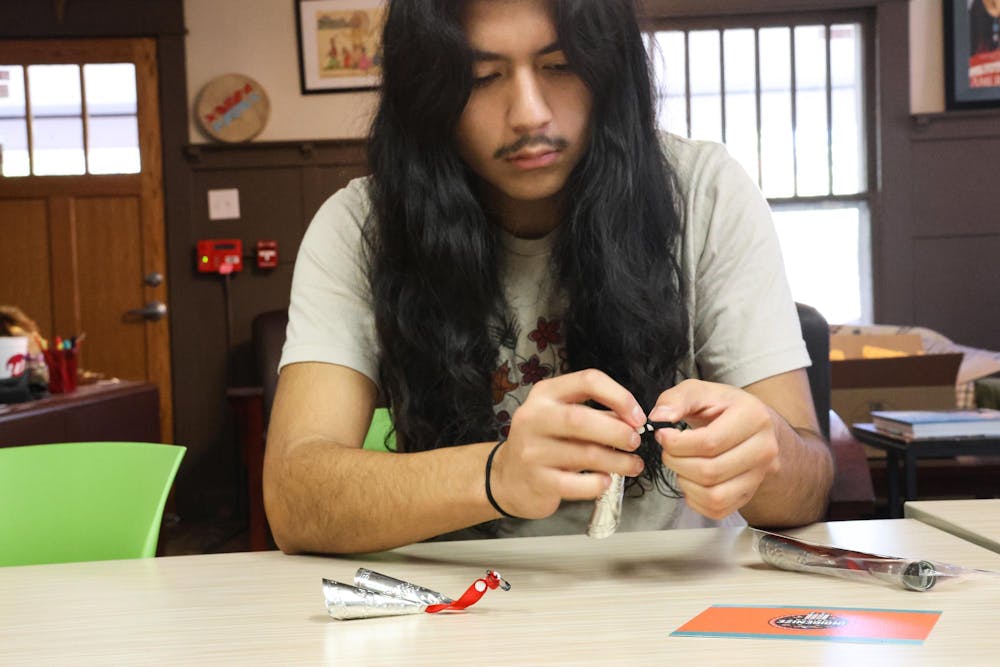It all began with the ringing of a bell. The noise coming from a student’s backpack in the Indiana Memorial Union reminded Richard Henne-Ochoa, the director of the IU Institute for Indigenous Knowledge, of the sounds of a powwow.
“I heard a bell, someone walking that had bells attached to their backpack,” he said. “The bell just sounded like that sound you hear when you’re at a powwow and there are dancers.”
Students may hear a similar bell-like jingle on Indigenous People’s Day, celebrated Oct. 14. The First Nations Educational and Cultural Center and the Institute for Indigenous Knowledge are distributing jingle cones for students to wear on Indigenous People’s Day to raise awareness of Native American issues. The cones can be picked up 10 a.m. to 5 p.m. Monday through Friday this week at the First Nations Educational and Cultural Center at 712 E. Eighth St.
The small metal cones are traditionally attached to a jingle dress worn by Indigenous powwow dancers. They originated among the Ojibwe, who live in the Great Lakes region, as a part of a healing dance.
“By using jingle cones and their sound as a symbol for consciousness-raising as well as a call to action, we’re actually drawing in a native symbol of healing,” Henne-Ochoa said.
The Jingle Cones for Justice Project at IU debuted this year; it focuses on bringing awareness to the damage residential boarding schools caused to Indigenous American communities.
During the 19th and 20th centuries, the U.S. and Canadian governments created over 500 boarding schools across North America. Several of these schools were in Indiana and aimed to assimilate Native students into white American culture. Many students were forcibly taken from their communities, and some never returned home.
The U.S. and Canadian governments implemented the schools to isolate Native students from their languages, religions and practices to eradicate their culture. While at the schools, Indigenous students faced emotional, physical and sexual abuse, and overcrowded, inhumane conditions led to disease and malnourishment. The exact number of children that attended the schools is unclear, but scholars estimate around 40,000 died at them. The last residential school in Canada didn’t shut down until 1996.
Henn-Ochoa said children were punished for speaking their native tongues and isolated from their parents.
“It’s only appropriate to have those kinds of cones as a symbol of healing, also tied to healing from the wounds and of the trauma of boarding schools,” Henne-Ochoa said.
Henne-Ochoa thought it would be compelling to have people wear the cones on Indigenous People’s Day so that others would be reminded of Indigenous issues and work toward healing.
“I started thinking, there are groups that try to raise awareness for causes through T-shirts and hats and stickers, and I don’t know of any that have used a sound to call attention to some kind of issue,” Henne-Ochoa said.
He said the First Nations Educational and Cultural Center have had the cones, which were traditionally made from tobacco can lids, for some time. They tied several together with a ribbon so that they clink when attached to clothing or backpacks.
The project asks for donations to the National Native American Boarding School Healing Coalition, a nonprofit with a mission to advocate for Indigenous people affected by the schools. Henne-Ochoa said that if the project is successful, he would consider making it an annual event.
“Historically speaking, IU’s faculty and students have benefited enormously from Indigenous people, in terms of Indigenous people's involvement in research projects,” Henne-Ochoa said. “But I think now, IU could be a leader in leveraging its resources to help Indigenous nations rebuild after centuries of colonization and genocide.”
He mentioned that IU could work with Native communities to return collections like linguistic and historical data, as well as cultural materials or artifacts, to the communities from which they were gathered. IU currently has several collections of Native subject matter, such as the Wanamaker collection of Native photographs and documents providing context for the images.
“I think IU could play a pivotal role, a major role, even take leadership in helping to get collections that are at universities and museums back to these communities from which they came,” Henne-Ochoa said.






